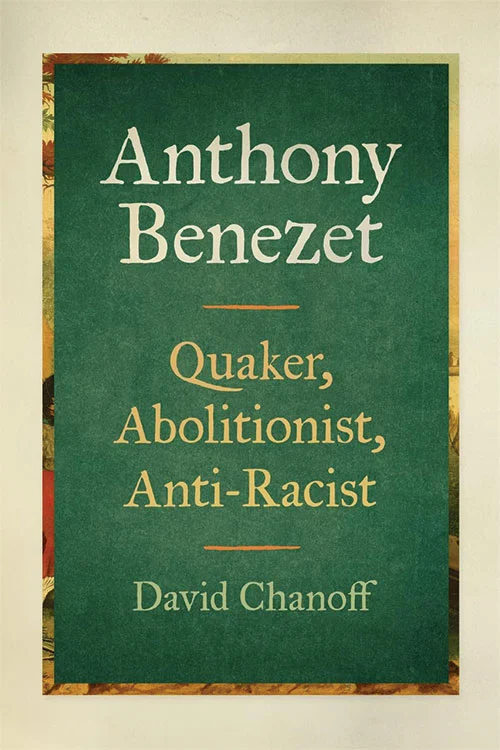
Anthony Benezet: Quaker, Abolitionist, Anti-Racist
Reviewed by Paul Buckley
November 1, 2025
By David Chanoff. University of Georgia Press, 2025. 232 pages. $32.95/hardcover; $24.95/eBook.
This is not the book I expected: a biography of Anthony Benezet. It is much more ambitious. David Chanoff starts out with a description of civil war in France, attempted religious genocide by Louis XIV, and the lives of Huguenot exiles in Holland, England, and the North American British colonies in the eighteenth century. The Benezet family was swept along by these currents, but little is known of them as distinct individuals. Antoine (Anthony) first appears as a two-year-old religious refugee escaping France with his parents and siblings in 1715. He then disappears from the text for 16 years until he and his family move to Philadelphia, Pa. In between, Chanoff fills in more background with chapters on the founding of the Religious Society of Friends, important early Quakers, and describing William Penn’s Holy Experiment in Pennsylvania. The first quarter of the book says little about Anthony Benezet, instead painting a detailed picture of the world in which he came to maturity.
Benezet was still floundering in his mid-20s when he happened into a job as a teacher and a career that was personally fulfilling as well as making a substantial contribution in the history of American education. In 1750, while teaching at what is today called William Penn Charter School, he started a night school to teach Black children in his own home—the first such school in the British North American colonies. Four years later, he gave up teaching at Penn Charter to establish the first public school for girls in the American colonies.
Earlier efforts by others to teach Black people had been motivated by a desire to convert them to Christianity and, thereby, to content them in their enslaved positions. The basis of these education efforts was that Black and white people were spiritually equal—all children of the same God—but not equal in their humanity. Benezet’s experience teaching Black and white children at the same time opened him to directly experience the equal humanity of Black and white people—all deserving the same rights and liberties.
Benezet, of course, was more than just an enlightened educator. In the rest of this book, the process by which Benezet was led, step by step, to become an essential actor in the abolition movement is explained: developing from a religiously motivated tract writer who hoped to cleanse the Society of Friends of the sins of slavery into a persuasive and passionate advocate for universal civil rights. In the course of his work, Benezet’s writing evolved in unique ways. He introduced the use of personal stories by those with direct experience in the slave trade (complete with references and footnotes) to give his readers a visceral sense of its horrors. In addition to tracts for the general population, he wrote personal letters to people of power and authority, thereby weaving a trans-Atlantic network of abolitionists. While little political progress was made in his lifetime, incessant pressure drove the British government to outlaw the slave trade in 1808, 24 years after Benezet’s death.
As in the early chapters, Chanoff does not limit himself to Benezet’s story. Brief biographies of dozens of other characters acting over 150 years pepper the text and give the reader a fuller picture of the multitudinous contributions needed over the course of decades to finally achieve the ban.
This book left me pondering Quakers’ complex role in all this. The Religious Society of Friends was first to forbid buying and selling humans into slavery, and they play an indispensable role in raising up the full humanity of enslaved people, but they seemed blind to their spiritual equality. While Anglicans, Baptists, and Methodists actively proselytized Black people (sometimes while simultaneously enslaving them), Quakers excused themselves from religious fellowship.
Chanoff’s work also leads me to wonder why, while we (rightly) celebrate the saintly John Woolman, our memories of Anthony Benezet are scant. After reading this book, I wonder if Quakerdom’s slow steps to eventually condemning slavery would have happened without Benezet’s extraordinary work within the Society—and his sometimes ignoring its stifling bounds.
This meticulously researched book highlights Anthony Benezet’s crucial role in energizing and shaping an emerging abolitionist movement. Chanoff showed me how lacking my knowledge was. For anyone seeking to understand the roots of the abolition movement and the Quaker contribution to their nourishment and growth, this book is essential reading.
Paul Buckley has written numerous articles and books on Quaker history, faith, and practice, and he has been active in urging spiritual renewal among Friends. He worships with Clear Creek Meeting in Richmond, Ind., and travels in the ministry among Friends. His most recent publication is the Pendle Hill pamphlet Teach Us to Pray. Contact: [email protected].



Comments on Friendsjournal.org may be used in the Forum of the print magazine and may be edited for length and clarity.